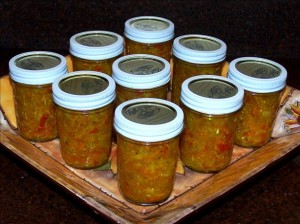While not exclusively a redneck food, chow-chow (the relish, not the dog), is certainly championed most by the rural folk of America, and with no uncertainty, is one of the sustainable marvels of our day. Seriously.
For you see, chow-chow is indeed the kitchen sink of canning. For my rural-impaired readers I will need to pause here for some clarification. Let’s start with canning.
Canning, for you urban folk, refers to the practice of preserving freshly grown fruits and vegetables in glass jars for use throughout the year. It is in and of itself a very sustainable practice due to its reliance on local produce rather than off-season stuff shipped from Timbuktu via carbon-emitting yack. And don’t think for a second that the “vine-ripened” tomatoes you find in January are anything of the sort, unless you live in California or think ripe means something like “edible enough to withstand commercial harvesting, processing, shipping and retail sale over the next week).

